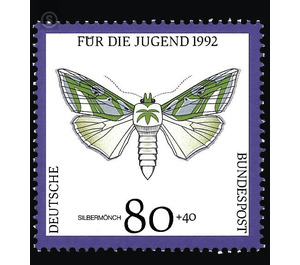youth: endangered moths - Germany / Federal Republic of Germany 1992 - 80 Pfennig
Theme: Animals
| Country | Germany / Federal Republic of Germany |
| Issue Date | 1992 |
| Face Value | 80.00 |
| Color | multi-colored white blue |
| Perforation | K 13 3/4 |
| Printing Type | Multicolor offset printing |
| Stamp Type | Postage stamp |
| Item Type | Stamp |
| Chronological Issue Number | 1477 |
| Chronological Chapter | GER-BRD |
| SID | 231827 |
| In 31 Wishlists | |
Whoever speaks of butterflies usually means the colorful, flower-visiting butterflies that fly in the sunshine during the day, such as the peacock's eye, the little fox or the cabbage white. Few know that about nine-tenths of all butterflies belong to the so-called "moths." However, this is a rather inaccurate (and unscientific) collective term that encompasses everything that is not just "butterflies", a vast, heterogeneous set of at least 150,000 species worldwide, to which about 60 different "families" are assigned (for comparison: butterflies, for example) 13,000 species, 5 families). The only thing they have in common is their nocturnal way of life (and even that is far from being the case in every species, as many have become diurnal again). The fact that they fly around at night, being lured by light sources and sometimes getting into apartments, is probably the main reason why this large group of insects has either remained largely unknown to the layman or even occasional encounters with these "moths" are considered unpleasant, though they are completely harmless. Hardly anyone knows, therefore, the splendor and beauty of many species, at least comparable to the butterflies, or the subtle aesthetics of the other, less conspicuously colored species. There are more than 2,000 species of moths in Germany and of course they are - as well as the butterflies - endangered by human interference in the natural environment and threatened in part their existence. That they, too, are an indispensable and worthy part of a whole, to which, last but not least, man belongs, is to draw attention to the small selection of native moths. The »owl butterflies« (Noctuidae) are with almost 25,000 species almost worldwide distributed and the most successful butterfly family ever. There are tiny species of less than 10 mm span, but also the moth with the largest span, the more than 25 cm measuring »Thysania agrippina« from the tropical areas of South America. In addition to widespread "common species", there are also food and habitat specialists in large numbers. One of them is the silver monk, a more commonly distributed lowland species that mainly populates heathland and other heat-favored sandy biotopes where its only caterpillar plant, Artemisia campestris, thrives. Due to its color, the caterpillar is so perfectly adapted to the flowers and fruits of this plant that it can hardly be detected even from close proximity. She makes, as soon as she grows up in September, a stable Erdkokon in which she pupates. It happens that the doll "overlays" for several years before the butterfly hatches. Hazard factors: Afforestation of heathland, abandonment of traditional uses (grazing, mowing for litter production), thereby bushing and displacement of the caterpillar feed plant.


